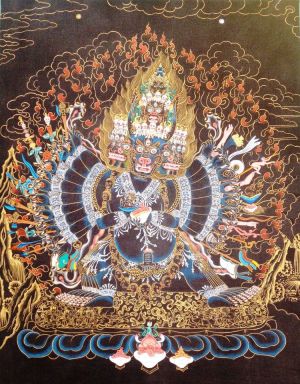Mandala Deities in Tibet and Nepal
Mandala first appeared in India about 1500 years ago and was introduced to Nepal, Tibet, Bhutan, China and Japan. Mandala is a sacred world of Buddhist deities, composed of orderly disposed hosts of deities and their imaginary palace.
This special exhibition highlights Mandalas constructed in Nepal and the Tibet Autonomous Region to explicate their structure.
The exhibits include Buddhist deities in Mandalas classified into five groups according to the form of images, such as Buddha, Bodhisattva (Buddha to be), and goddesses. Three-dimensional models of Mandala will help the visitors understand the structure of Mandala. Visitors are expected to stay in the Vajradhatu Mandala set up at the center of the Special Exhibition Hall to feel the “sacred” space of Budhhist deities.
1. Mandala and the organic body
While Mandala generally depicts Buddha and Bodhisattva orderly disposed in the imaginary square Palace built on the summit of Mt. Sumeru which stands on earth, water, fire and wind, it is repeatedly emphasized in the Buddhist canons that the entire Mandala is a representation of the spiritual embodiment of a meditating Buddha.
In addition to the notion that Mandala as the universe represents the body of Buddha, Konchog Huntub, a Tibetan monk in the 16th century, referred to Mandala also as a representation of an organic body of an ascetic in meditation, describing as follows; The organic body of an ascetic transforms into the Mandala composed of the lotus and the living body. His sole represents wind and his thigh represents fire. Likewise, the stomach stands for water, the heart for earth, the spinal cord for the Mt. Sumeru, which rises in the center of the world-unit, and the top of Mt. Sumeru is a transformation of the head.
Regarding the world as a living body which comes into being and grows to extinction, the world or nature is integrated into the life cycle of the organic body. Under the influence of such a notion, the life cycle of the living body is elaborately reflected in the design of Mandala. An ascetic will envisage the fact that he/she and the world are contained in the life cycle when standing in front of the Mandalas.
In Buddhist Tantrism, the world and nature merit being sacred because they are believed to be the embodiment of Buddha. We can derive many suggestive messages from the idea that the cosmos is the sacred living body.
3. Mandala and life energy
It is hard to overestimate today the fact that Buddhist Tantrism puts the significance of being sacred on life energy and the entire world as cosmos which have continued since the beginning of life activity. The significance has long been nurtured in the history of life activity shared by people and nature. Therefore, it would be worthy of the power to prevent destruction of nature and stop people killing each other.
Nature is neither an object nor tool for people to put under control. Reality in which living activity is done stands for a relationship that nothing is subject to others, and it is called Engi (Dependent Co-arising) which has been highly appreciated in Buddhism. The correlation between Buddha and ordinary people or that of nature and human beings is regarded as Engi relationship. Mandala is a symbolic representation of the sacred reality of life activity.
Source
http://www.minpaku.ac.jp/english/museum/exhibition/special/200303/introduction
